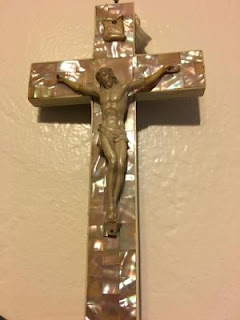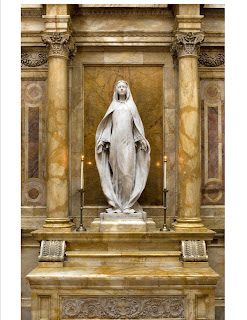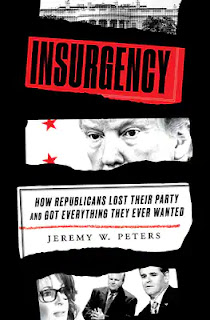It’s Good Friday, that so paradoxically named day, the first of three days (beginning at sunset yesterday and ending at sunset on Sunday) when, united with Christians of every time and place, we contemplate Christ crucified, buried, and risen. This is the Passover of the Lord.
The unique story of Jesus’ death, burial, and resurrection is intimately wrapped up with the ancient story of the Lord’s Passover. As John’s Gospel reminds us, Jesus died on the afternoon before the beginning of Passover, even as the Passover lambs were being sacrificed in the Temple, and was hastily buried because the festival was about to begin. His accusers would not enter Pilate’s headquarters in order not to be defiled so that they could eat the Passover.
Passover celebrates the most important event in ancient Israel’s history – not just as something interesting that happened, once upon a time, but as something powerfully real and meaningful in the present, and as a sign of hope for the future. In the challenging words of the Passover ritual: In every generation let all look on themselves as having personally come forth from Egypt. … It was not only our ancestors, blessed be He, that the Holy One redeemed, but us as well did he redeem along with them. … In every generation they stand up against us to destroy us, and the Holy One, blessed be He, saves us from their hand.
At the exodus, the blood of the lamb marked the doors of the houses of God’s People in Egypt. In Jesus’ time, the blood of the lamb was sprinkled on the altar of the Temple in Jerusalem. Now, however, now that the great high priest, Jesus, has passed through the heavens, the blood of the lamb has been shed, once and for all, on the altar of the cross – our doorway to salvation.
Marked by the blood that saves us all, the cross has thus become the Church’s door. The cross is now, thanks to this day, our gateway to freedom and new life, and so a triumphant sign of glory for us and for all.
Of course, in the citadels of imperial power and our postmodern popular secular culture (so like the imperial governor Pontius Pilate in the caustic skepticism that simply dismisses the disconcerting possibility of something so definite and restricting as truth), the cross can only seem an ugly, nonsensical failure – what Saint Paul famously called a scandal and a stumbling block. But the paradoxical power of the cross is that Christ’s true triumph lay precisely not in his dramatically descending from the cross, as if he were some celebrity or actor, but in ascending the cross as a condemned criminal, one of many throughout humanity’s long and tortured history – a paradox succinctly summarized by the prophet Isaiah: he was cut off from the land of the living, and smitten for the sin of his people … But … the will of the Lord shall be accomplished through him … and he shall take away the sins of many, and win pardon for their offenses.
It was this strangely paradoxical text that, not so many years after the events we commemorate today, an Ethiopian court official was reading and struggling to understand, when he encountered the evangelist Philip and asked him: I beg you, about whom is the prophet saying this? Philip, Luke tells us in the Acts of the Apostles, opened his mouth and, beginning with this scripture passage, he proclaimed Jesus to him. With Philip, the unanimous witness of authentic Christian tradition has recognized – in Jesus crucified, buried, and risen – the one who perfectly fulfills the prophet’s paradoxical words.
As the thrust of the soldier’s lance into Jesus’ side certified, Jesus really died on the cross. Then, bound with burial cloths according to the custom, his body was buried – all of which should then have been the end of the story. Were that the case, of course, we would hardly remember the events we commemorate today. We would hardly remember, let alone mourn, Jesus himself.
But in fact we do remember, although we do not mourn. Today, instead of mourning, we celebrate the cross of Christ.
As St. John Chrysostom expressed it, so many centuries ago: Before, the cross was synonymous with condemnation; now it is an object of honor. Before, a symbol of death; now the means of salvation. It has been the source of countless blessings for us: it has delivered us from error, it has shone on us when we were in darkness. We were vanquished, yet it reconciles us with God. We were foes, yet it has regained God’s friendship for us. We were estranged, yet it has brought us back to him.
That is why today, in monumental basilicas and soaring cathedrals and tiny churches and rural missions, we will everywhere solemnly salute the wood of the cross, on which hung the salvation of the world. In every generation, we too must look upon the cross of Christ and embrace it. So let us confidently approach the throne of grace to receive mercy and to find help in our time of need.
Today, we will venerate the cross individually (imitating Mary, his mother standing by the cross of Jesus), for each one of us is challenged as a disciple to realign his or her life, to model one’s life on the mystery of Christ’s cross – despite the difficulties life seems to put in the way, despite the obstacles each individual sinner personally puts in the way. Today too, we will venerate the cross together as the community of Christ’s holy Church – born on the cross in the blood and water which flowed out from Jesus’ side as a sign of the Church’s sacramental life and mission – because it is together as Christ’s Church (united with Mary, the Mother of the Church) that we continue Christ’s life and mission, effectively extending the reach of his cross into the whole world.
Passing through life this way, standing by the cross of Jesus and reborn as his Church in his blood and water, we will ourselves become Passover doorways, through which the Risen Lord’s gift of salvation will flow from his side to fill our entire world.





